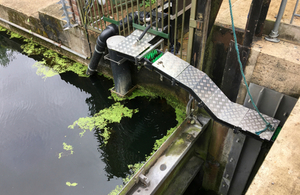Environment Agency’s efforts see Norfolk’s eel population boosted
Environment Agency efforts to improve access to freshwater habitats for Norfolk eels have seen encouraging results for second year running.

Eel pass at New Mills Yard in Norwich City Centre
Increased numbers of eels have been observed at a Norwich fish pass, as well as sightings further upstream on the River Tud, the first to be found in that location for nearly 40 years.
Jez Wood, a specialist at the Environment Agency, said:
Last month 2 small eels were found on a routine fish survey on the Tud, a tributary of the Wensum.
Two doesn’t sound like many, but these are the only small eels we’ve found on this stretch for years, and only the fifth and sixth of this size found in the Wensum catchment since 1973.
Whilst this does not herald the recovery of the species as a whole, it does show the positive benefit of eel passes at barriers to migration and the monitoring programme at the Environment Agency.
The global eel population has dropped dramatically over the past 40 years, with numbers down by as much as 95%. Whilst there are thought to be many reasons for this decline, barriers to upstream migration are one that we can do something about.
These barriers reduce access to freshwater habitat in which many eels prefer to live while they mature, before migrating back across the Atlantic to the Sargasso Sea where they spawn and die.
In Norfolk barriers include tidal sluices, weirs and mills. Eel passes are helping the Environment Agency ensure the population can be restored and stabilised.
The status of the European eel is still regarded as “critical” and the Environment Agency is creating passes at several key obstruction locations on Norfolk Rivers, such as New Mills Yard, in Norwich.
Eel numbers are monitored by the Environment Agency at various tidal structures and also in fish monitoring surveys on the rivers. Since the New Mills pass was installed in 2009, the number of eels have ranged from the hundreds to a record 34,000 in 2016.
These are not new eels fresh from the Sargasso, but older eels which have spent time in the Broads for maybe 2 or 3 years before attempting to migrate upstream.
Whilst it’s not known why the numbers of eels fluctuate so greatly, the general increase in numbers and the findings upstream are positive signs for the health of our rivers.
Factfile: Lifecycle of eels
Much is still unknown about the lifecycle of the European eel.
It is catadromous, which means it spends most of its time in freshwater but returns to sea to breed.
The larval stage of the eel, called Leptocephala, migrate across the Atlantic drifting on the Gulf Stream before metamorphosing into the glass eel stage 7 centimetres when they enter continental waters around September.
They reach the estuaries in the UK from October/November in the South West and spread over the rest of Britain over the next few months, though don’t tend to actively migrate upstream until the spring.
Glass eels start passing tidal structures in April and through the summer and gradually become pigmented elvers. The urge to migrate upstream is not consistent – not all glass eels migrate past the tidal barriers in the first year. Some elvers stay in the estuary never entering the rivers, some stay in the estuary and enter the river in subsequent years.
Those that do enter the rivers can migrate upstream for several years, moving during the warmer months so the downstream reaches tend to be dominated by younger age-classes whilst upstream areas can contain only old/large individuals, predominately female.
Growth rates vary, but females reach between 45 and 85cm 10 to 12 years post-metamorphosis and males between 30 and 45cm 6 to 10 years post-metamorphosis.
At this point physical changes occur, and they change from yellow eels to silver eels and they start the downstream migration in late summer and autumn and return to the Sargasso where it is believed that they spawn and die, though this behaviour has never been witnessed.